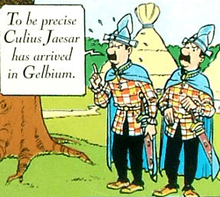Asterix in Belgium
| Asterix in Belgium (Astérix chez les Belges) | |
|---|---|
 | |
| Date | 1980 |
| Series | Asterix |
| Creative team | |
| Writers | René Goscinny |
| Artists | Albert Uderzo |
| Original publication | |
| Date of publication | 1979 |
| Language | French |
| Chronology | |
| Preceded by | Obelix and Co. |
| Followed by | Asterix and the Great Divide |
Asterix in Belgium (French: Astérix chez les Belges, lit. 'Asterix among the Belgians') is the twenty-fourth volume of the Asterix comic book series, by René Goscinny (stories) and Albert Uderzo (illustrations).
It is noted as the last Asterix story from Goscinny, who died during its production.
Plot summary
After fighting the Belgians, Caesar declares them the bravest enemies he has ever faced (historically claimed by Caesar). His soldiers agree with him, and therefore consider being posted to the camps outside Asterix' village as a period of leave. Chief Vitalstatistix is aghast at the idea thereof; claims that his own villagers are the bravest men of Gaul; and travels to Belgium to prove his point. A reluctant Asterix and Obelix go with him, at the advice of Getafix. After crossing the border, they encounter a village of Belgians led by two chiefs, Beefix and Brawnix. To prove that his own Gauls are the bravest, Vitalstatistix proposes a competition of raiding and destroying Roman camps on either side of the Belgian village, and thereupon identifying themselves to vanquished commanders. By the end of the contest, they have destroyed an equal number of camps, and word is sent to Rome, wherein the facts are exaggerated to include "vast hordes of Gauls, accompanied by savage packs of hounds [Dogmatix]", aided by a naval fleet (the recurring pirates). Caesar goes to Belgium himself to restore order, and is informed by Asterix and Obelix of the competition and its exigence. When requested to arbitrate between the two factions, Caesar instead issues a declaration of battle. Upon hearing this, Beefix insists that his visitors remain aloof. Through the use of catapults the Romans gain an advantage; but are defeated when Asterix, Obelix, and Vitalstatistix intervene. When Beefix and Vitalstatistix ask Caesar which side is the bravest, Caesar declares them "all equally crazy" and leaves. Vitalstatistix and Beefix are thereupon reconciled, and the two factions hold a victory feast. In the epilogue, Asterix, Obelix, and Vitalstatistix return to their own village, to a second celebration.
Notes

- Beefix' wife is a caricature of Walloon actress and singer Annie Cordy.
- Features a small cameo from the two detectives Thomson and Thompson from the world famous Belgian comic strip Tintin, who characteristically mispronounce the name of Julius Caesar. The scene is even drawn in a line-style similar to Hergé's, the writer of the Tintin comics.
- It also features the famous cyclist Eddy Merckx as a messenger.
- Goscinny died halfway through writing the comic; as a homage to him, Uderzo drew rain into the comic for the rest of the album, to mark the point at which Goscinny died. This also serves as a spoof on the Belgian weather.
- The entire final battle between the Gallo-Belgian and Roman sides is a parody of the Battle of Waterloo, in present-day Belgium. In the French edition, the text scrolls and quotes on them are a stylistic parody of Victor Hugo's text Les Châtiments, about the Battle of Waterloo; whereas even the English edition contains references to the same battle. During the battle the Roman commander is depicted as saying "La garde meurt mais ne se rend pas" ("The guard dies, it does not surrender!"), a quote attributed to the French general Pierre Cambronne at the Battle of Waterloo in 1815. The pose he takes while saying this is similar to Cambronne's statue in Nantes.
- Of all the Asterix books, this one contains the most literary references to earlier works, including Plutarch's Lives, Caesar's own Gallic Wars, and (in the English translation) Shakespeare's Tragedy of Julius Caesar.
- The picture of the victory feast at the Belgian village is a parody of the Flemish painting The Peasant Wedding (De Boerenbruiloft) by Pieter Bruegel the Elder.
- The small child that is last seen running to urinate somewhere is a reference to the iconic Belgian statue Manneken Pis.
In other languages
- Catalan: Astèrix a Bèlgica
- Croatian: Asterix u Belgiji
- Czech: Asterix u Belgů
- Danish: Styrkeprøven
- Dutch: Asterix en de Belgen
- Finnish: Asterix Belgiassa
- German: Asterix bei den Belgiern
- Greek: Ο Αστερίξ στους Βέλγους
- Italian: Asterix e i Belgi
- Norwegian: Styrkeprøven (The test of strength)
- Polish: Asteriks u Belgów
- Portuguese: Astérix entre os Belgas
- Serbian: Asteriks i Obeliks u Belgiji (Астерикс и Обеликс у Белгији)
- Spanish: Astérix en Bélgica
- Turkish: Asteriks Belçika'da
- Indonesian: Asterik Di Belgia
- Swedish: Asterix i Belgien
References
External links
- Astérix chez les Belges annotations (French)